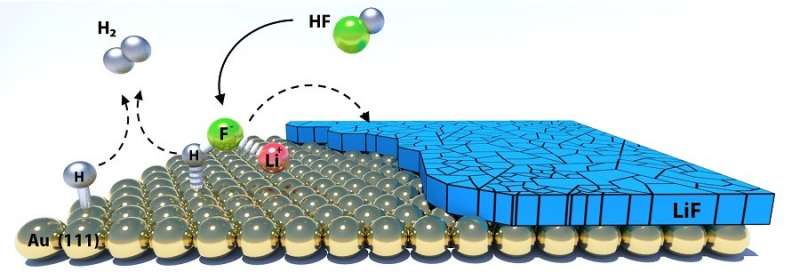Battery's hidden layer revealed

Commercially available since the 1970s, the lithium-ion battery is now the workhorse power source in many applications. It can be found in cell phones, laptops and electric vehicles. Yet, much about the basic science taking place at the atomic and molecular levels during charge and discharge remains a mystery.
In a new study published in Nature Catalysis, a team at the U.S. Department of Energy's (DOE) Argonne National Laboratory reports a breakthrough in understanding the chemistry of the microscopically thin layer that forms at the interface between the liquid electrolyte and solid electrode. Battery researchers commonly refer to this layer as the "solid-electrolyte interphase" or SEI.
Much scientific work over the last several decades has been devoted to understanding the SEI in the lithium-ion battery. Scientists know that the SEI forms on the graphite negative electrode, is extremely thin (less than a thousandth of a millimeter), and primarily takes shape during the first charge of the battery. Also well-established is that the SEI prevents detrimental reactions from occurring at the interface, while at the same time allowing the important lithium ions free rein to move between the electrolyte and electrode.
All good lithium-ion batteries have well-functioning SEIs. As Dusan Strmcnik—a co-principal investigator and assistant chemical engineer in the Materials Science division (MSD)—noted, "Battery performance is highly dependent on the quality of the SEI. If the chemistry and the role of individual components of the SEI are understood, the SEI could be tuned to improve battery performance."
"More importantly, such understanding would significantly improve our predictive ability of battery lifetime, which is of extremely high value to an electric car manufacturer," Strmcnik added.
The international team of researchers, which includes collaborators from the University of Copenhagen, the Technische Universität München in Germany and the BMW Group, deciphered the chemistry behind one of the more common components of the SEI in typical lithium-ion batteries, lithium fluoride. Based on both experimental and computational results, their findings showed that this phase forms during battery charge by the electrochemical reaction of hydrogen fluoride, producing hydrogen gas and solid lithium fluoride.
This reaction depends highly on the electrode material, which could be a metal, graphene or graphitic material, and thus demonstrates the importance of catalysis in battery operation. The team discovered a new method for monitoring the concentration of the hydrogen fluoride, a highly detrimental impurity that forms from a reaction between trace amounts of moisture and the salt (LiPF6) in the electrolyte. This monitoring capability should prove vital to future basic science studies of the SEI.
To Argonne Distinguished Fellow and co-principal investigator Nenad Markovic, the study's results are already having a commercial impact. "Our findings are already being implemented in lithium-ion cells at the Battery Cell Competence Center of the BMW Group. They will also open new opportunities for the improvement of existing, and the design of new, lithium-ion technologies."
The Nature Catalysis article is titled "Electrocatalytic Transformation of HF Impurity to H2 and LiF in Lithium-Ion Batteries."
More information: Dusan Strmcnik et al. Electrocatalytic transformation of HF impurity to H2 and LiF in lithium-ion batteries, Nature Catalysis (2018). DOI: 10.1038/s41929-018-0047-z
Journal information: Nature Catalysis
Provided by Argonne National Laboratory





















